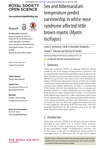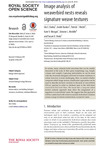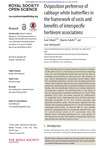Search
Now showing items 21-30 of 67
City lifemakes females fussy: sex differences in habitat use of temperate bats in urban areas
(The Royal Society, 2014)
Urbanization is a major driver of the global loss of biodiversity to mitigate its adverse effects, it is essential to understand what drives species’ patterns of habitat use within the urban matrix. While many animal species ...
Eye spots in Lepidoptera attract attention in humans
(The Royal Society, 2015)
Many prey species exhibit defensive traits to decrease their chances of predation. Conspicuous eye-spots, concentric rings of contrasting colours, are one type of defensive trait that some species exhibit to deter predators. ...
Wind plays a significant role in the flight altitudes selected by nocturnally migrating birds. At mid-latitudes in the Northern Hemisphere, atmospheric conditions are dictated by the polar-front jet stream, whose amplitude increases in the autumn. One consequence for migratory birds is that the region’s prevailing westerly winds become progressively stronger at higher migration altitudes
(The Royal Society, 2015)
Seasonal changes in the altitudinal distribution of nocturnallymigrating birds during autumnmigration.
Modality specific attention in foraging bumblebees
(The Royal Society, 2015)
Attentional demands can prevent humans and other animals from performing multiple tasks simultaneously. Some studies, however, show that tasks presented in different sensory modalities (e.g. visual and auditory) can be ...
Sex and hibernaculum temperature predict survivorship inwhite-nose syndrome affected little brownmyotis
(The Royal Society, 2015)
White-nose syndrome (WNS), an emerging infectious disease caused by the novel fungus Pseudogymnoascus destructans,has devastated North American bat populations since its discovery in 2006. The little brown myotis,Myotis ...
Image analysis of weaverbird nests reveals signature weave textures
(The Royal Society, 2015)
In nature, many animals build structures that can be readily measured at the scale of their gross morphology (e.g. length, volume and weight). Capturing individuality as can be done with the structures designed and built ...
Polygyny without wealth
(The Royal Society, 2015)
The occurrence of polygynous marriage in hunter–gatherer societies, which do not accumulate wealth, remains largely unexplored since resource availability is dependent on male hunting capacity and limited by the lack of ...
Oviposition preference of cabbage white butterflies in the framework of costs and benefits of interspecific herbivore associations
(2015)
When deciding where to oviposit, herbivorous insects consider: (i) the plant’s value as a food source, (ii) the risks of competing with con- and heterospecific herbivores, and (iii) the risks of parasitism and predation ...
Social dominance modulates eavesdropping in zebrafish
(The Royal Society, 2015)
Group living animals may eavesdrop on signalling interactions between conspecifics and integrate it with their own past social experience in order to optimize the use of relevant information from others. However, little ...
Trophic niche divergence among colour morphs that exhibit alternative mating tactics
(2016)
Discrete colour morphs associated with alternative mating tactics are assumed to be ecologically equivalent. Yet suites of behaviours linked with reproduction can also favour habitat segregation and exploitation of different ...










